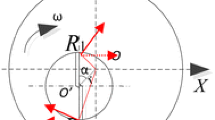Abstract
Research in micromilling processes has found that tool deflection phenomenon affects the forces significantly, causing a smoothing effect in the tool run-out. Therefore, this needed to be taken into account to design a model for reliably predicting the cutting forces in these processes. In this paper, a study of the tool deflection phenomenon was carried out by applying the principles of elasticity of materials to the situation of a tool under a distributed force along its edge. The contribution of this study consisted of considering a variable deflection along the length of the edge, which has not been taken into account in previous models. A new methodology of obtaining the rigidity, based on experimental data, was applied to two specific types of mills by using their geometry. With this model, a linear equations system that allows the prediction of cutting forces was obtained. These predictions, which were calculated with a low computational cost, can be used in monitoring systems and adaptive control of the process for the prevention of tool failure.
Similar content being viewed by others
References
Nakamoto K, Ishida T, Kitamura N, Takeuchi Y (2011) Fabrication of microinducer by 5-axis control ultraprecision micromilling. CIRP Ann Manuf Technol 60(1):407–410
Brousseau E, Dimov S, Pham D (2010) Some recent advances in multi-material micro-and nano-manufacturing. Int J Adv Manuf Technol 47:161–180
Rodriguez P, Perez H, Labarga J, Vizan A (2008) Research on tool life in micro-end-milling as related to workpiece quality criteria. Proceedings of the Early Technical Career Conference, Miami, pp 163–165
DeVor RE, Kline W, Zdeblick WJ (1980) A mechanistic model for the force system in end milling with application to machining airframe structures. 8th North Am Manuf Res Conf 8:297–303
Smith S, Tlusty J (1991) An overview of modeling and simulation of the milling process. J Eng Ind 113:169–175
Carboloy Systems Department (1980) Milling handbook of high-efficiency metal cutting. Published by General Electric Company, London
Tlusty P, MacNeil J (1975) Dynamics of cutting forces in end milling. CIRP Ann 24:21–25
Tlusty J (1985) Machine dynamics. In: King RI (ed) Handbook of high-speed machining technology. Chapman and Hall, New York
Sutherland JW, DeVor RE (1986) Improved method for cutting force and surface error prediction in flexible end milling systems. J Eng Ind 108:269–279
Mamedov A, Layegh SE, Lazoglu KI (2013) Machining forces and tool deflections in micro milling. Procedia CIRP 8:147–151
Tlusty J, Ismail F (1983) Special aspects of chatter in milling. Trans ASME 105:24
Rodríguez P, Labarga JE (2013) A new model for the prediction of cutting forces in micro-end-milling operations. J Mater Process Technol 213:261–268
Budak E, Altintas Y, Armarego EJA (1996) Prediction of milling force coefficients from orthogonal cutting data. J Manuf Sci Eng Trans ASME 118:216–224
Cardoso P, Davim JP (2012) A brief review on micromachining of materials. Rev Adv Mater Sci 30:98–102
Davim JP (2008) Machining: fundamentals and recent advances, Springer-Verlag, London Limited
Nash WA (1998) Schaum’s outline of theory and problems of strength of materials. Schaum’s Outline Series, McGraw Hill
Davim JP, Jackson MJ (eds) (2010) Frontmatter, in Nano and Micromachining, ISTE, London, UK. doi:10.1002/9780470611807.fmatter
Aramcharoen A, Mativenga PT (2009) Size effect and tool geometry in micromilling of tool steel. Precis Eng 33:402–407
Kim CJ, Mayor JR (2004) A static model of chip formation in microscale milling. J Manuf Sci Eng 126:710
Câmara MA, Rubio JCC, Abrão AM, Davim JP (2012) State of the art on micromilling of materials, a review. J Mater Sci Technol 28:673–685
Pérez H, Vizán A, Hernandez JC, Guzmán M (2007) Estimation of cutting forces in micromilling through the determination of specific cutting pressures. J Mater Process Technol 190:18–22
Özel T, Liu X, Dhanorker A (2007) Modelling and simulation of micro-milling process. In 4th International Conference and Exhibition on Design and Production of Machines and Dies/Molds pp 21–23
Kuram E, Ozcelik B (2013) Multi-objective optimization using Taguchi based grey relational analysis for micro-milling of Al 7075 material with ball nose end mill. Measurement 46:1849–1864
Bissacco G, Hansen HN, Slunsky J (2008) Modelling the cutting edge radius size effect for force prediction in micro milling. CIRP Ann Manuf Technol 57:113–116
Bao WY, Tansel IN (2000) Modeling micro-end-milling operations. Part I: analytical cutting force model. Int J Mach Tools Manuf 40:2155–2173
Jaffery SI, Driver N, Mativenga PT (2010) Analysis of process parameters in the micromachining of Ti-6Al-4V alloy. In Proceedings of the 36th International MATADOR Conference. Springer, London, pp 239–242
Mian AJ, Driver N, Mativenga PT (2011) Identification of factors that dominate size effect in micro-machining. Int J Mach Tools Manuf 51:383–394
Newby G, Venkatachalam S, Liang SY (2007) Empirical analysis of cutting force constants in micro-end-milling operations. J Mater Process Technol 192–193:41–47
Dornfeld D, Min S, Takeuchi Y (2006) Recent advances in mechanical micromachining. CIRP Ann Manuf Technol 55:745–768
Mian A, Driver N, Mativenga P (2011) Estimation of minimum chip thickness in micro-milling using acoustic emission. Proc Inst Mech Eng Pt B: J Eng Manuf 225:1535–1551
Vogler MP, Devor RE, Kapoor SG (2004) On the modeling and analysis of machining performance in micro-end-milling: II. Cutting force prediction. J Manuf Sci Eng 126:695
Author information
Authors and Affiliations
Corresponding author
Rights and permissions
About this article
Cite this article
Rodríguez, P., Labarga, J.E. Tool deflection model for micromilling processes. Int J Adv Manuf Technol 76, 199–207 (2015). https://doi.org/10.1007/s00170-014-5890-8
Received:
Accepted:
Published:
Issue Date:
DOI: https://doi.org/10.1007/s00170-014-5890-8




